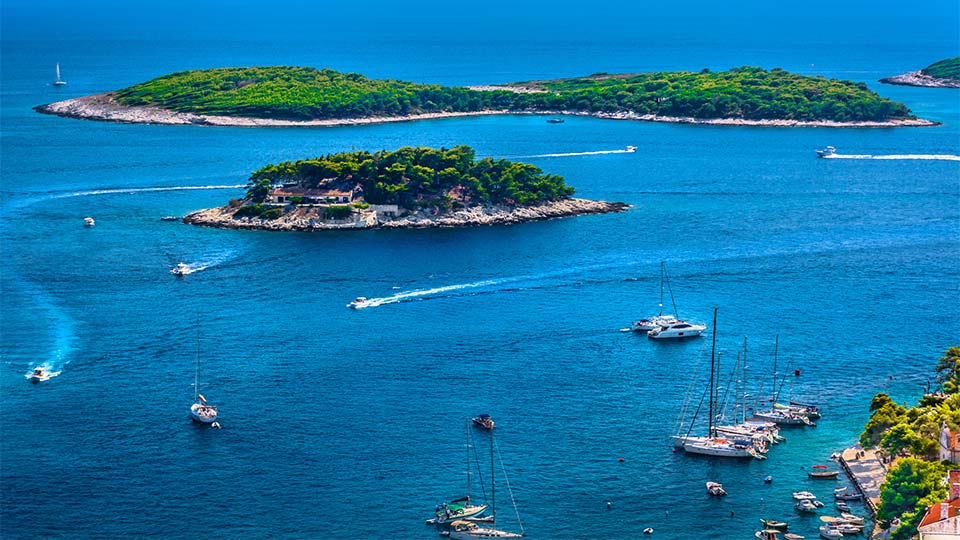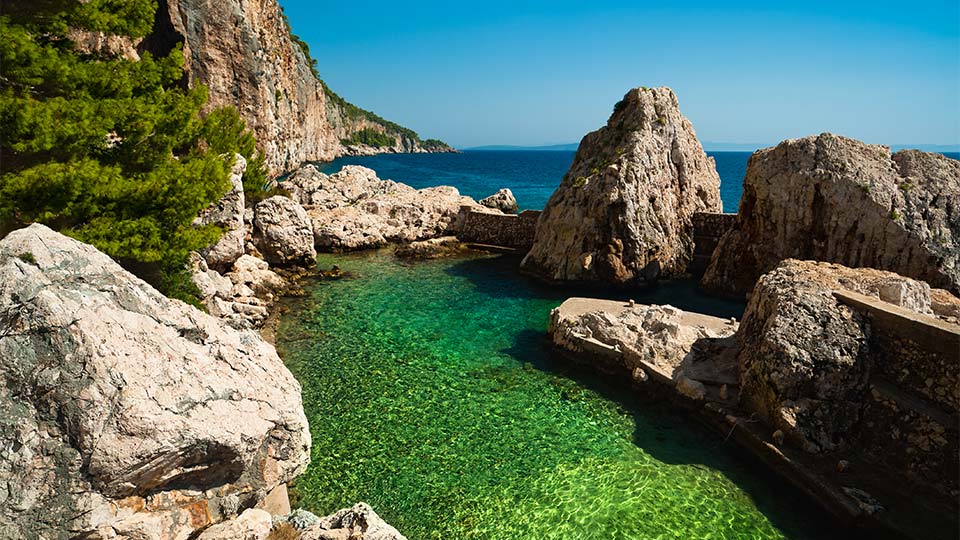
Sunny
Trogir, Marina Trogir (ex.SCT), Croatia
€ 11.393,00
€ 15.990,00
09 Aug - 16 Aug 2025
Heads: 4 + 1
Max persons: 10
Published: 26. March, 2020
Our 7 days South route will take you through most exciting places in Croatia:
Day 1 : Kaštela - Milna (Brač)
Milna is the most protected as well the most beautiful port on the island of Brač. Protected from stronger winds and refreshed by the maestral wind of summer afternoons, it is the ideal haven for people and boats alike. Milna is situated at the bottom of a spacious cove at the western coast of Brač. Crystal blue sea, shades of centennial pine trees, sunlit facades built of Brač stone, ideal diving conditions, domestic and healthy food - all the reasons for coming to this beautiful Mediterranean town. There is a large selection of excellent fish restaurant, pizzerias and many caffe bars in Milna, situated in the vicinity of the sea. ACI marina Milna is located in the southeastern part of the Milna cove, adjacent to the town.
Day 2: Milna - Stari Grad (Hvar) - Hvar (Hvar)
Stari Grad is the oldest city in Croatia, a peer of Aristotle. It is situated at the end of a bay 4 nm deep, along the northwest coast of the island of Hvar. Due to its central position, it has been a seamen's sanctuary for centuries. Today, the Stari Grad cove is an obligatory stop for sailors cruising the Adriatic. The city is surrounded by vineyards, olive tree orchards and pine woods. Underwater fishing is possible along the southern coast of Kabel peninsula, which closes around the bay. Stari Grad is not protected against northern winds. Within the Stari Grad bay, the coves Zavala and Tiha offer shelter from the northern winds; the coves Gračište, St. Ante and Maslinica offer shelter from the southern winds. Hvar is one of the most desired and most visited destinations on the Dalmatian riviera. It is characterised by a warm, pleasant climate with lots of sun, a picturesque natural environment, various options for quality accommodation, Mediterranean cordiality and hospitality, numerous restaurants and taverns offering exquisite domestic specialties and wines, sports and recreation possibilities, an active night life. Thanks to its position along the ancient maritime route, Hvar has a far richer history than any other island on the Adriatic. The city port has protection against stronger winds.
Day 3: Hvar (Hvar) - Vis (Vis)

The island of Vis is the destination of choice for those who desire the experience of the unique, today largely lost, true Mediterranean atmosphere and way of life. A unique cultural and historical heritage, crystal clear sea, beautiful, secluded beaches, and many small coves and isles will leave you breathless. The entire history of Vis is linked to fishing, wine growing and wine production. The most renowned authentic white wine is the famous Vugava of Vis, which you can taste in many restaurants and wine cellars here. The town of Vis is situated on the north side of the island, along the beautiful cove of St. Juraj, which appears closed in a ring-like formation by the isle of Host. Numerous luxurious restaurants and traditional taverns in the very centre of town, will attract you with domestic specialties and a pleasant atmosphere. The port of Vis has protection against stronger winds.
Day 4: Vis - Biševo - Komiža (Vis)
Komiža, the port and town, is situated on the west coast of the island of Vis, along the northeastern side of the spacious bay of Komiža. The port is protected against the east and northeastern winds, but is exposed to the west and southwestern winds. Komiža is considered the cradle of fishing in the Adriatic, as the Fishermen's museum in town testifies. Unique in Croatia, it is located in the old Venetian tower. The construction of wooden ships over the centuries has given birth to the "falkuša", a fishing ship endemic to Komiža, unique in the world for its specific build and sails. Not far from the island of Vis, a small paradise island rises from the sea - Biševo. It is renowned for its beautiful sandy beaches, colourful underwater life and unusual natural phenomena. The coastline of Biševo is dotted with many caves, the most famous of which being the Blue Cave, in the Balun cove. On sunny days, at high noon, the sunlight penetrates the cave through its underwater entrance, reflecting off the white rock bottom and illuminating the cave in astounding shades of blue. Entry to the Blue Cave is permitted by small rowboat only, and only in quiet, waveless weather.
Day 5: Komiža - Palmižana (Hvar)
Off the southwestern coast of the island of Hvar, a group of around 20 isles and reefs is situated, known as the Pakleni otoci. Pakleni islands are a unique and the most distinguished natural beauty of the island of Hvar. Forested isles amidst crystal clear blue sea, countless secluded beaches and beautiful desolate inlets, present a far-known sunny Arcadia of Hvar. The best shelter on Pakleni otoci is the ACI marina Palmižana on the northeastern coast of the isle of St. Klement, which is shielded from all winds. However, in a strong southwestern wind, some tidal waves may occur. Palmižana is the oldest and best known resort on Hvar. It is surrounded by thick pine forests and various other exotic vegetation.
Day 6: Palmižana - Trogir

Trogir is a museum-city in every sense. In all of Central Europe it is considered as the best preserved Romanesque-Gothic city. The castle and the tower, surrounded by stone walls, contain the old core of Trogir. The most significant cultural monument is the Trogir cathedral. Its western gate Portal, built by master Radovan, stands for the most monumental piece of Romanesque-Gothic sculpture in Croatia. Trogir thrills its visitors with its many cultural-historic monuments and narrow alleys, and its many art collections with numerous masterpieces. The city of Trogir is situated upon the coast of the Kaštela bay, on an island connected to another island - Čiovo and the mainland by stone bridges. ACI marina Trogir is located on the north side of Čiovo, between the Trogir bridge and cape Čubrijan, opposite to the city of Trogir. The Trogir riviera is marked by rich Mediterranean vegetation, olive orchards as vineyards, numerous islands and inlets, gravelly and sandy beaches. Well indented, pristine coastline is very favourable to sailors.
Day 7: Trogir - Uvala Krknjaši (Veli Drvenik) - Kaštela
Veli Drvenik is an island in the Split riviera, only 6,2 nautical miles off the coast of Trogir. With a surface of 12 km2 and shore length of 23 km, it is highly indented and therefore very suitable as a nautical destination. All underwater activities around Drvenik are strictly forbidden. Krknjaši bay is a cove on the east side of the island, well protected from the winds, especially west and northwestern ones, and is an excellent anchorage. A small resort in the cove offers accommodation and domestic specialties. Kayaking trips are organised around the island as well, as its mild weather conditions and shallow waters, coupled with pristine natural beauty make the area irresistible for adventurous visitors.
Can't find what you are looking for? Have a look at our Hot Summer Deals.
Planning your dream sailing getaway? Reach out and our experts at Noa Yachting will guide you every step of the way.